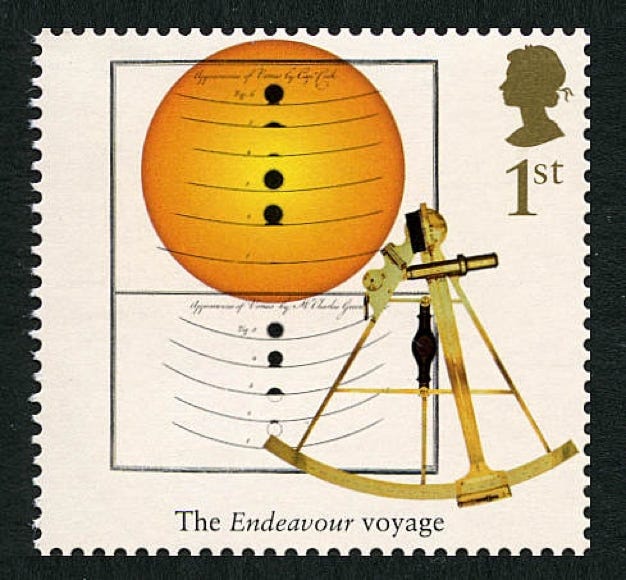2018 Captain Cook and the Endeavour voyage
Royal Mail commemorated the 250th anniversary of Captain Cook’s first around-the-world voyage with a set of six stamps and a mini sheet released in 2018 August. Only one of the stamps, shown above, illustrated the primary purpose of the voyage: to observe the transit of Venus from the Pacific island of Tahiti on 1769 June 3 as part of an international effort to measure the size of the Solar System.
Cook’s ship, HMS Endeavour, sailed from Plymouth in August 1768 and arrived in Tahiti the following April. Tahiti was chosen to provide a suitable north–south baseline for the observations of the path of Venus across the Sun. As seen from Tahiti the track of Venus would be significantly different from that seen by observers in the northern hemisphere, and the exact difference would allow the distance of Venus to be calculated by trigonometry.
Cook’s scientific team included the astronomer Charles Green; the naturalists Joseph Banks, Daniel Solander, and Herman Spöring; and two artists, Sydney Parkinson and Alexander Buchan. Cook, Green, and Solander successfully observed the transit through separate telescopes from a sandspit on the northern tip of Tahiti that is still called Point Venus.
However, their timings of the start and finish of the event, which were critical to the final calculations, were affected by the so-called black drop. This is an optical effect in which the transiting planet appears to be connected to the edge of the Sun by a dark tongue even after it has moved fully on to the Sun’s disk, and again when it is about to move off again. Even so, their observations, combined with those from observers in the northern hemisphere, allowed astronomers to calculate the distance between the Earth and Sun to an accuracy of better than 1%.
HMS Endeavour arrived back in England on 13 July 1771, nearly three years after her departure. Green had died during the return voyage, leaving Cook to write up the observations of the transit, which were published in the Philosophical Transactions of the Royal Society later that year. Cook credited Green as the lead author.
On the commemorative stamp Cook and Green’s drawings of the transit are superimposed on an image of the Sun. The design also includes a sextant, although this was not used for the transit observations; rather, its purpose was for for position-finding while at sea.
Designed by Howard Brown, the six stamps in the Captain Cook and the Endeavour Voyage set were as follows:
• 2nd class: Portrait of Joseph Banks by Sir Joshua Reynolds (National Portrait Gallery), with drawings of a red-tailed tropicbird (Phaethon rubricauda) and orange-petalled passion flower (Passiflora aurantia) by Sydney Parkinson (Natural History Museum).
• 2nd class: Dress of a masked Chief Mourner of Tahiti by Tupaia, a local Tahitian who joined Cook’s crew and helped him navigate around the islands. In the background is a Tahitian scene, also by Tupaia. (British Library)
• 1st class: James Cook as he appeared in 1776 before his third and last voyage in a famous portrait by Nathaniel Dance (National Maritime Museum), and HMS Endeavour from a 1966 painting called Triumph of the Navigators by Robin Brooks.
• 1st class (illustrated above): Transit of Venus observations by James Cook and Charles Green, as published in the Philosophical Transactions of the Royal Society, with the Sun in the background and a sextant made by Jesse Ramsden. The black drop effect can be seen on Cook and Green’s drawings. The limb darkening of the Sun, which is one of the contributory factors to the black drop, is clearly noticeable in the photograph, which was taken during the transit of 2004 June 8 by Eckhard Slawik in Germany; however, Venus itself has been touched out of the photograph.
• £1.45: A scarlet clianthus (Clianthus puniceus), also known as a kaka beak, by Sydney Parkinson (Natural History Museum), and Parkinson’s drawing of a Maori chief with face tattoo.
• £1.45: Self-portrait by Sydney Parkinson (Natural History Museum) and his drawing of a blue-black grassquit (Volatinia jacarina).
For stamps from other nations commemorating Captain Cook and the 1769 transit see here.
Stanley Gibbons no. ???
